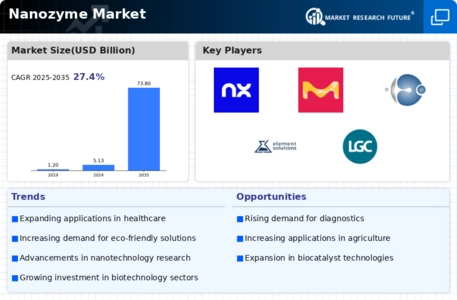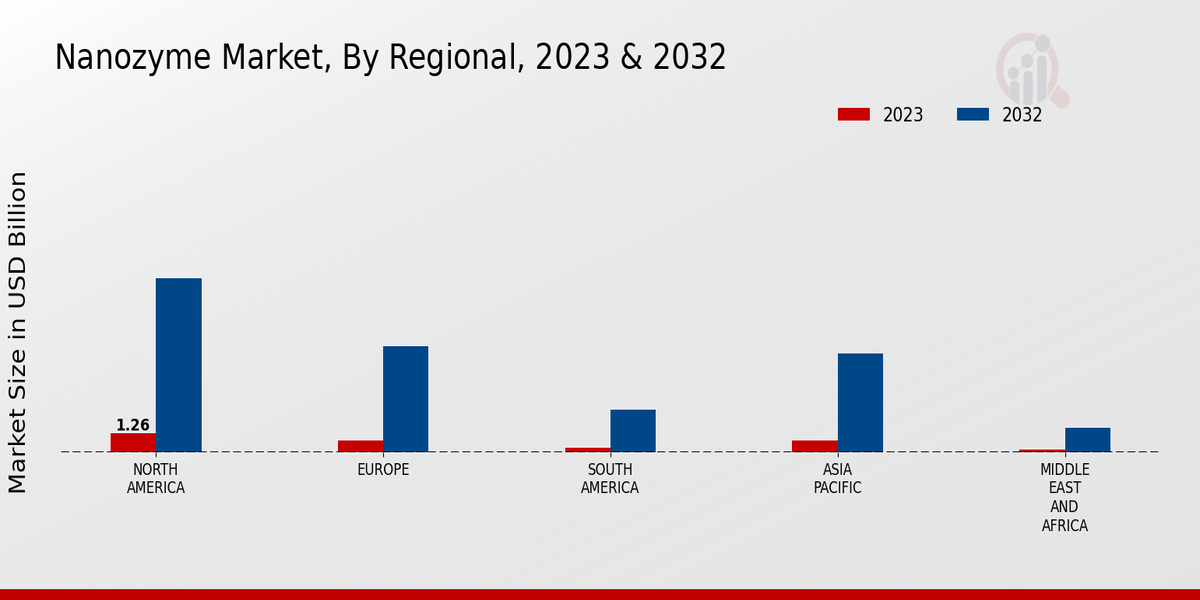Market Growth Projections
The Global Nanozyme Market Industry is poised for remarkable growth, with projections indicating a market size of 5.13 USD Billion in 2024 and an anticipated increase to 73.8 USD Billion by 2035. This growth trajectory reflects a compound annual growth rate of 27.44% from 2025 to 2035. Such figures illustrate the increasing recognition of nanozymes across various sectors, including healthcare, agriculture, and environmental applications. The expanding range of applications and the ongoing advancements in nanotechnology are likely to drive this market growth, positioning nanozymes as a critical component in future technological developments.
Advancements in Nanotechnology
Technological advancements in nanotechnology are significantly influencing the Global Nanozyme Market Industry. Innovations in synthesis and characterization techniques are enabling the development of more efficient and targeted nanozymes. For example, the use of advanced imaging techniques allows for better understanding of enzyme behavior at the nanoscale, leading to improved performance in various applications such as biosensing and drug delivery. These advancements not only enhance the efficacy of nanozymes but also broaden their applicability across different sectors. As a result, the market is expected to witness substantial growth, with projections indicating a rise to 73.8 USD Billion by 2035.
Growing Applications in Healthcare
The healthcare sector is increasingly adopting nanozymes for various applications, thereby propelling the Global Nanozyme Market Industry. Nanozymes are being utilized in diagnostics, therapeutics, and drug delivery systems due to their unique properties. For instance, their ability to mimic natural enzymes allows for enhanced catalytic activity in biological systems. This has led to the development of novel diagnostic tools that provide rapid and accurate results. As the demand for efficient healthcare solutions rises, the integration of nanozymes into medical applications is expected to expand, further driving market growth.
Emerging Markets and Global Expansion
Emerging markets are playing a pivotal role in the expansion of the Global Nanozyme Market Industry. Countries in Asia-Pacific and Latin America are witnessing a surge in industrial activities, leading to increased adoption of nanozymes in various sectors. For example, the agricultural sector in these regions is exploring nanozymes for enhancing crop yields and pest resistance. This trend is indicative of a broader acceptance of nanozyme technologies across diverse industries. As these markets continue to develop, they are likely to contribute significantly to the overall growth of the nanozyme market.
Rising Demand for Eco-Friendly Catalysts
The Global Nanozyme Market Industry is experiencing a notable increase in demand for eco-friendly catalysts. As industries seek sustainable alternatives to traditional chemical catalysts, nanozymes offer a promising solution due to their biocompatibility and efficiency. For instance, the use of nanozymes in wastewater treatment has shown to reduce harmful pollutants effectively. This shift towards greener technologies aligns with global sustainability goals, potentially driving the market's growth. The market is projected to reach 5.13 USD Billion in 2024, reflecting a growing recognition of the environmental benefits associated with nanozyme applications.
Increasing Investment in Research and Development
Investment in research and development is a critical driver for the Global Nanozyme Market Industry. Governments and private sectors are allocating significant resources to explore the potential of nanozymes in various fields, including medicine, agriculture, and environmental science. For instance, funding initiatives aimed at developing nanozyme-based therapies for cancer treatment are gaining traction. This focus on R&D is likely to accelerate innovation and commercialization of nanozyme products, contributing to a robust market growth trajectory. The anticipated compound annual growth rate of 27.44% from 2025 to 2035 underscores the potential impact of these investments on the industry.

















Leave a Comment